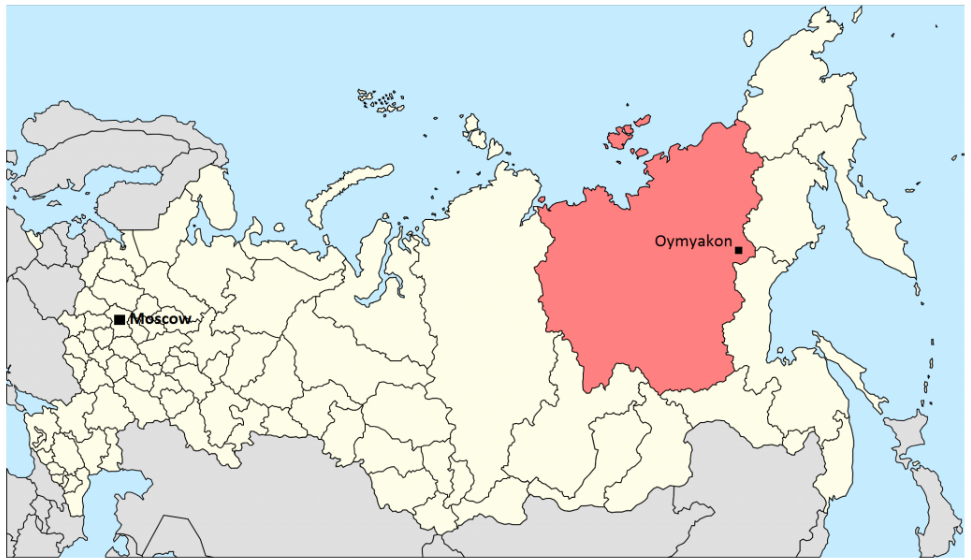3.2: Settlement and Development Challenges
- Page ID
- 21061
Russia’s size and varied physiographic regions have presented some challenges for its population. Much of Russia is simply too cold for widespread human settlement. Thus, even though Russia is the largest country, the area that is suitable for agriculture and intensive development is much smaller. In Russia’s northern regions, agricultural development is restricted by short growing seasons and frequent droughts. As snow melts, it takes topsoil with it, and thus erosion is a serious issue in these areas as well.
Still, some have carved out settlements in this frigid environment. Oymyakon, located in northeastern Russia, is considered to be the coldest permanently inhabited places in the world (see Figure \(\PageIndex{1}\)). It has a population of around 500 and temperatures here once dropped to -71.2°C (-96°F)! It takes 20 hours to reach Oymyakon from the nearest city of Yakutsk.

Industry, too, is hampered by Russia’s cold climate in the Siberian region. Although Siberia accounts for over three-quarters of Russia’s land area, it contains only one-quarter of its population. In a region so sparsely populated, how do you build roads, factories, and large settlements? Even if there are resources present, as there are, how do you get them to nearby industrial areas? The industrial developments and human settlements that do exist in this region require high energy consumption and highly specialized facilities needed to cope with cold temperatures and permanently frozen soil.
However, global changes in climate have had some dramatic effects on Russian geography. Areas that were previously permafrost have begun to thaw, leading to erosion and mud, which both present challenges for development. In Siberia, giant holes in the ground began to appear around 2014 and initially baffled scientists. These massive holes were later found to be pockets of methane gas trapped in previously frozen soil that had thawed due to the warming climate. If global temperatures continue to climb, the area of permafrost will shrink, increasing the potential for agriculture in northern Russia. New oil and gas reserves that were previously trapped under frozen soil could likewise become available. Previous shipping routes along Russia’s eastern and northern coasts that were covered in ice could become passable.
While warming temperatures might seem beneficial for Russia’s frigid northern region, they are accompanied by more troublesome long-term concerns. It is estimated that a huge amount of carbon, around 1600 gigatons (or 1.6 trillion tons), is stored in the world’s permafrost. The methane and carbon released from these permafrost stores could exacerbate global warming. Changing temperatures have also been associated with the increased risk of wildfires. In Russia, peatlands, areas of partially decayed vegetation, are particularly at risk. There has been an increase in droughts and flooding throughout Russia and many scientists believe that Russia’s close proximity to the Arctic Circle makes it even more vulnerable to changes in temperature.
Climate factors have also shaped the distribution of Russia’s population. Most of Russia’s population lives west of the Ural Mountains where the climate is more temperate and there are more connections with Eastern Europe (Figure \(\PageIndex{2}\)). Russia is highly urbanized, with almost three-quarters of the population living in cities. Its largest city and capital, Moscow, is home to around 12 million people.

Russia’s population has experienced some interesting changes over the past few decades. Its population peaked at over 148 million in the early 1990s before experiencing a rapid decline. When geographers explore a country’s population, they don’t just ask “Where is it changing?” but also “Why is it changing?” For Russia, the economic declines coinciding with the dissolution of the Soviet Union contributed to low birth rates. Generally, when a country experiences economic decline or uncertainty, people tend to delay having children. Today, due to higher birth rates and a government push to encourage immigration, Russia’s population growth has stabilized and could grow from 143.5 million in 2013 to 146 million by 2050. Russia’s death rate remains quite high, however, at 13.1 per 1000 people compared to the European Union average of 9.7 per 1000. Alcoholism rates are high, particularly among men in Russia, and cardiovascular disease accounts for over half of all deaths. In addition, although Russia is highly urbanized, more people are now moving from Russia’s crowded cities to more sparsely populated rural areas, in contrast to the more common rural to urban migration seen elsewhere in the world.


